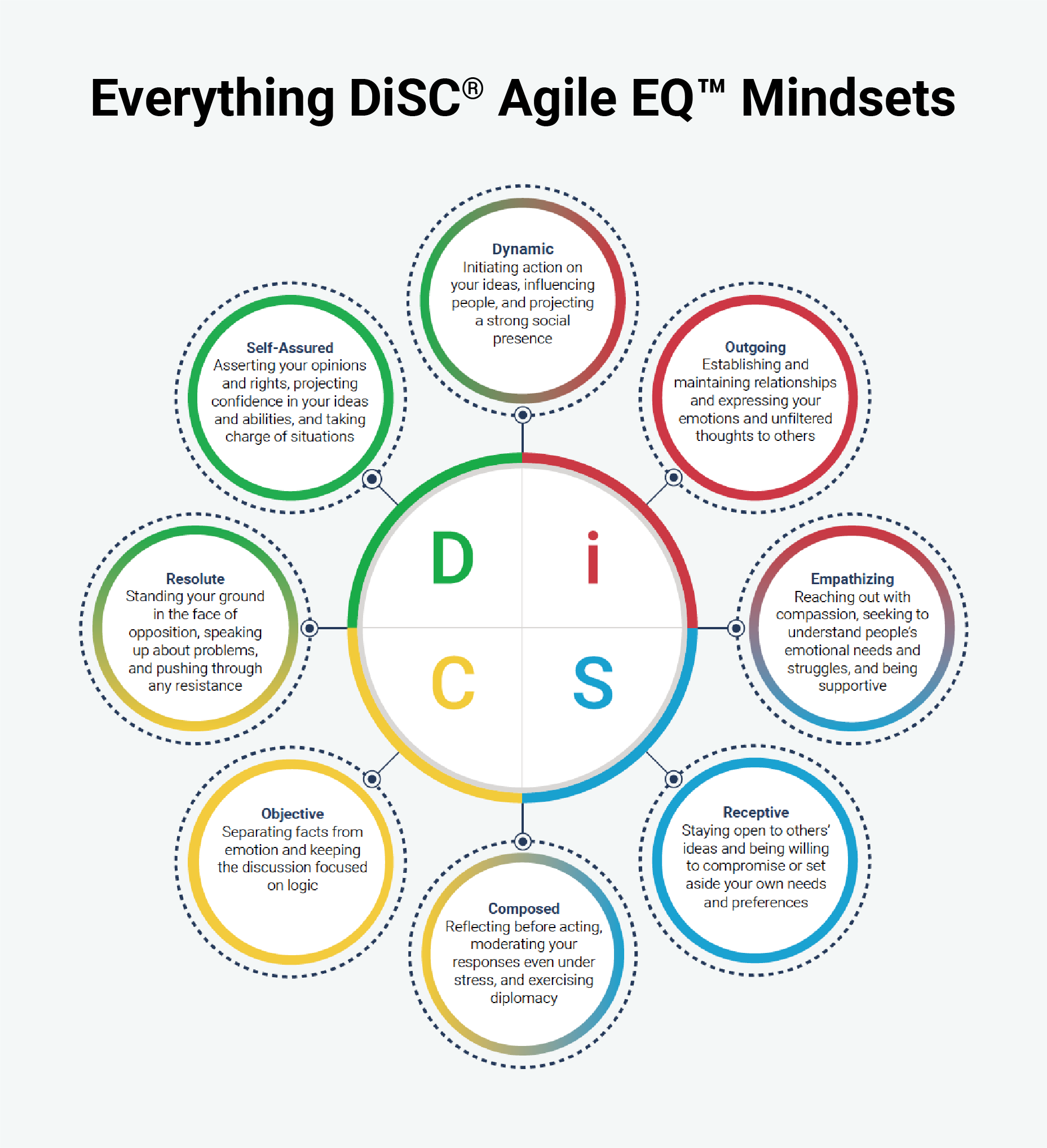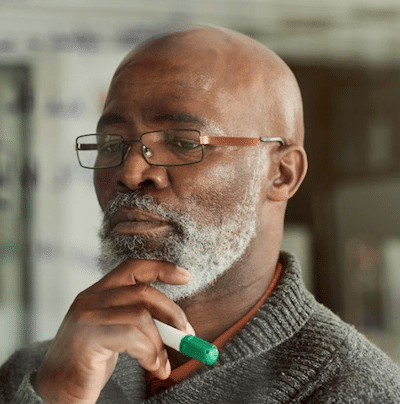
Emotional intelligence (EQ)
Why do some people have a knack for keeping calm? Why are some so persuasive? How is it that some people can maintain focus on a goal while others tend to lose steam? Why do some people embrace risk and others minimize it?
We all have particular mindsets that come naturally to us, so much so that they become automatic. But when you over-rely on the tendencies that are comfortable to you, it can distort the way you look at the world. And because other points of view take more effort, you might not recognize when a situation calls for them.
Everything DiSC® Agile EQ™ helps learners understand their own natural mindsets and see that all mindsets are valuable and needed—there’s not one that works in every situation. It provides tips and guidance for learning to stretch to responses that might initially feel uncomfortable, making learners better at navigating interpersonal and ambiguous situations.

The 8 Agile EQ mindsets
There are eight Agile EQ mindsets you can call on to guide your interactions:
- Receptive: keeping an open mind and considering other perspectives
- Composed: appearing calm and diplomatic
- Objective: thinking rationally and clearly
- Resolute: resisting pressure to cave in
- Self-assured: projecting confidence and taking charge
- Dynamic: influencing others and taking action on new ideas
- Outgoing: building up relationships and expressing unfiltered thoughts
- Empathizing: understanding others and reaching out to be supportive
Just as there’s no one DiSC® style that is better than another, there’s no Agile EQ mindset that is more valuable or effective than others. Rather, the needs of a particular situation dictate which is appropriate.
Emotional intelligence is problem-solving
The Agile EQ model proposes that an emotionally intelligent person is one who:
- Recognizes which mindsets are most appropriate in a given situation, and
- Stretches to use those mindsets, regardless of how comfortable they are.
This ability to read the situation and stretch to a new approach is called agility. Emotional intelligence (EQ) is a way to solve problems; agility helps you do that in real time. It’s not that a high-EQ person necessarily has better instincts, it’s that they recognize that instinct isn’t enough. You need the best possible approach, not just the one that’s easiest. And this will change with each new situation.
Develop your emotional agility
How to be more…
How to be more…
How to be more…
How to be more…
How to be more…
How to be more…
How to be more…
How to be more…
Examples of emotional agility
Think back to an interaction you had recently. How was your response based in instinct? How would you have responded if you approached it from a different attitude? Consider these scenarios:
Sara
Sara’s natural mindset is empathizing. Her coworker Charlie is stressed about a last-minute project that needs to be done over the weekend. He talks to Sara about how overwhelmed he is, and asks if she can do the project instead. Sara’s instinct may be to agree to take on the project because doing so will lessen Charlie’s stress. As a naturally empathetic person, she has compassion for what others are going through and wants to find ways to support them. So Sara may take on this extra work even if it is not her job to do so, or she has important plans during the weekend. This could lead to resentment on Sara’s part, and Charlie might start dumping more of his work on her. There are many subtle ways this interaction could contribute to unhealthy team dynamics.
If, during the conversation, Sara decided to approach it from an objective mindset, she wouldn’t suddenly lose her natural empathy for Charlie. Rather, she would recognize and acknowledge it, but also realize that the project is Charlie’s to do and explain this to him, moving the conversation into a space where they can both look at the situation rationally.
Or if Sara adopts the self-assured mindset, she may respond to Charlie’s request with a kind but firm answer such as, “No, it doesn’t make sense for me to do this project, but here’s what we can do.…” Sara could then guide Charlie through how to get the information and resources he needs to feel confident completing the work on his own. By coaching Charlie through developing a plan, Sara is still able to help him feel less stress (something her empathizing self values). There are ways to help beyond doing his work for him.
Arun
Arun’s natural mindset is receptive. He is presenting a new idea to his team at their weekly meeting. It’s an idea he has researched a great deal and that he knows is likely to succeed. When he brings it up at the meeting, his coworker Eva suggests a different idea, just off the cuff. Even though Arun has put a lot of work into his idea, and the one Eva proposes doesn’t make much sense to him, his receptive disposition leads him to stay open to it. So, when the team’s discussion shifts toward Eva’s idea, Arun doesn’t push back. Thus, Arun’s idea doesn’t get the consideration it deserves, and the team chooses a direction that won’t be as successful.
If Arun has been practicing emotional agility, he can read what’s happening in the room, and reach beyond his instincts. Perhaps he pivots to a resolute mindset, telling himself not to get distracted by other ideas right now, to stay on message. He still believes that other viewpoints are important, but he owes it to his idea to make sure his team considers it first.
Arun’s EQ work can start in advance, too. If Arun has an understanding of his natural tendencies, he can go into the meeting with a mindset that suits the situation and his goals. He may recognize that pitching a new idea often calls for being dynamic. Before the meeting, he reviews what he knows about his teammates and spends time putting together an argument that he knows will excite them. Perhaps he starts with a story to get them all interested. He brings engaging handouts or slides. He presents his idea with passion and energy, making it hard for them not to see its potential.
Learn to stretch beyond your comfort zone
In each of these scenarios, an agile approach brings Sara and Arun to an outcome that works well for them and their coworkers. And though stretching into another frame of mind may have taken more effort, they didn’t have to turn into different people or change their core personalities. They used their EQ skills to find the best solution to the problem at hand.
Your mind is like a GPS, creating go-to routes (the default responses you reach for time and again). When you try to deviate, the GPS wants to steer you back to the known route. It takes persistence to train your mind to stay open to other options. For example, if you have trouble speaking up at meetings, it is not realistic to expect you can become a fierce debater overnight. But you can start by looking for low-stakes chances to make your voice heard, with people you know will listen to you. And with practice, you’ll begin speaking up in more difficult situations.
Moving from a fixed mindset to a growth mindset gives you the ability to adapt your response to whatever situation you’re facing. It will cause you some initial discomfort, but developing your Agile EQ can help you reach your goals, enrich your relationships, and engage with the world in a new way.
This four-minute video gives a good overview of Everything DiSC Agile EQ:
You can’t be an agile organization without agile workers. The key to developing an agile workforce is emotional intelligence (EQ).
How our brains can stand in the way of productive workplace conflict, how conflict impacts efficiency and engagement, how hidden and counter-intuitive our conflict responses can be, and how CBT (reframing your thoughts) can unleash productive conflict responses instead.








